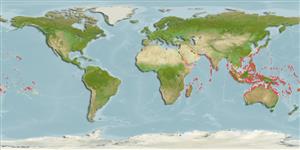Teleostei (teleosts) >
Eupercaria/misc (Various families in series Eupercaria) >
Labridae (Wrasses) > Corinae
Etymology: Stethojulis: Greek, stetho, stethion = brest; literal = to prick a little breast + Greek, ioulis, a fish dealing with genera Coris or Thalassoma (Ref. 45335).
More on author: Bennett.
Environment: milieu / climate zone / depth range / distribution range
Ecology
Marine; reef-associated; depth range 2 - 15 m (Ref. 48636). Tropical; 30°N - 30°S
Indo-Pacific: Red Sea and East Africa south to Algoa Bay, South Africa (Ref. 4392) and east to the Marshall and Tuamoto islands. In the western Pacific, extends from Sagami Bay, Honshu to New South Wales (Australia).
Size / Weight / Age
Maturity: Lm ? range ? - ? cm
Max length : 15.0 cm TL male/unsexed; (Ref. 2334); 7.0 cm TL (female)
Dorsal spines (total): 9; Dorsal soft rays (total): 11; Anal spines: 3; Anal soft rays: 11. First spine of the anal fin is minute or imbedded (Ref. 1602). Terminal males of S. strigiventer and S. bandanensis are similar, but in S. strigiventer the uppermost lateral blue streak rather than the lowermost one extends to the tail (Ref. 1602).
Inhabits seagrass beds and areas of mixed sand, rubble, and algae of inner reef flats and shallow lagoons. Female length is from Ref. 9137. Swims in small aggregations over large areas. Maximum depth reported taken from Ref. 48636.
Life cycle and mating behavior
Maturity | Reproduction | Spawning | Eggs | Fecundity | Larvae
Oviparous, distinct pairing during breeding (Ref. 205).
Randall, J.E., 2000. Revision of the Indo-Pacific labrid fishes of the genus Stethojulis, with descriptions of two new species. Indo-Pac. Fish. (31):42 p. (Ref. 36378)
IUCN Red List Status (Ref. 130435: Version 2024-1)
Threat to humans
Harmless
Human uses
Fisheries: commercial; aquarium: commercial
Tools
Special reports
Download XML
Internet sources
Estimates based on models
Preferred temperature (Ref.
123201): 24.9 - 29.3, mean 28.4 °C (based on 3102 cells).
Phylogenetic diversity index (Ref.
82804): PD
50 = 0.5010 [Uniqueness, from 0.5 = low to 2.0 = high].
Bayesian length-weight: a=0.00813 (0.00490 - 0.01347), b=3.00 (2.86 - 3.14), in cm total length, based on LWR estimates for this species & Genus-body shape (Ref.
93245).
Trophic level (Ref.
69278): 3.1 ±0.1 se; based on diet studies.
Resilience (Ref.
120179): High, minimum population doubling time less than 15 months (Preliminary K or Fecundity.).
Fishing Vulnerability (Ref.
59153): Low vulnerability (10 of 100).
Nutrients (Ref.
124155): Calcium = 95.3 [55.1, 161.4] mg/100g; Iron = 0.752 [0.432, 1.407] mg/100g; Protein = 18.4 [15.5, 20.6] %; Omega3 = 0.14 [0.09, 0.22] g/100g; Selenium = 20.9 [12.7, 37.6] μg/100g; VitaminA = 136 [43, 504] μg/100g; Zinc = 1.9 [1.3, 3.1] mg/100g (wet weight);
